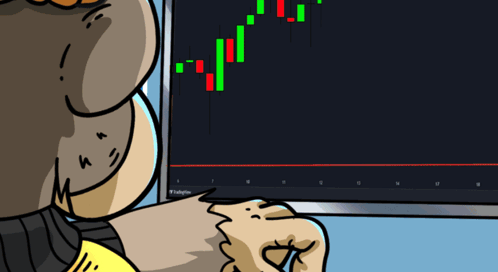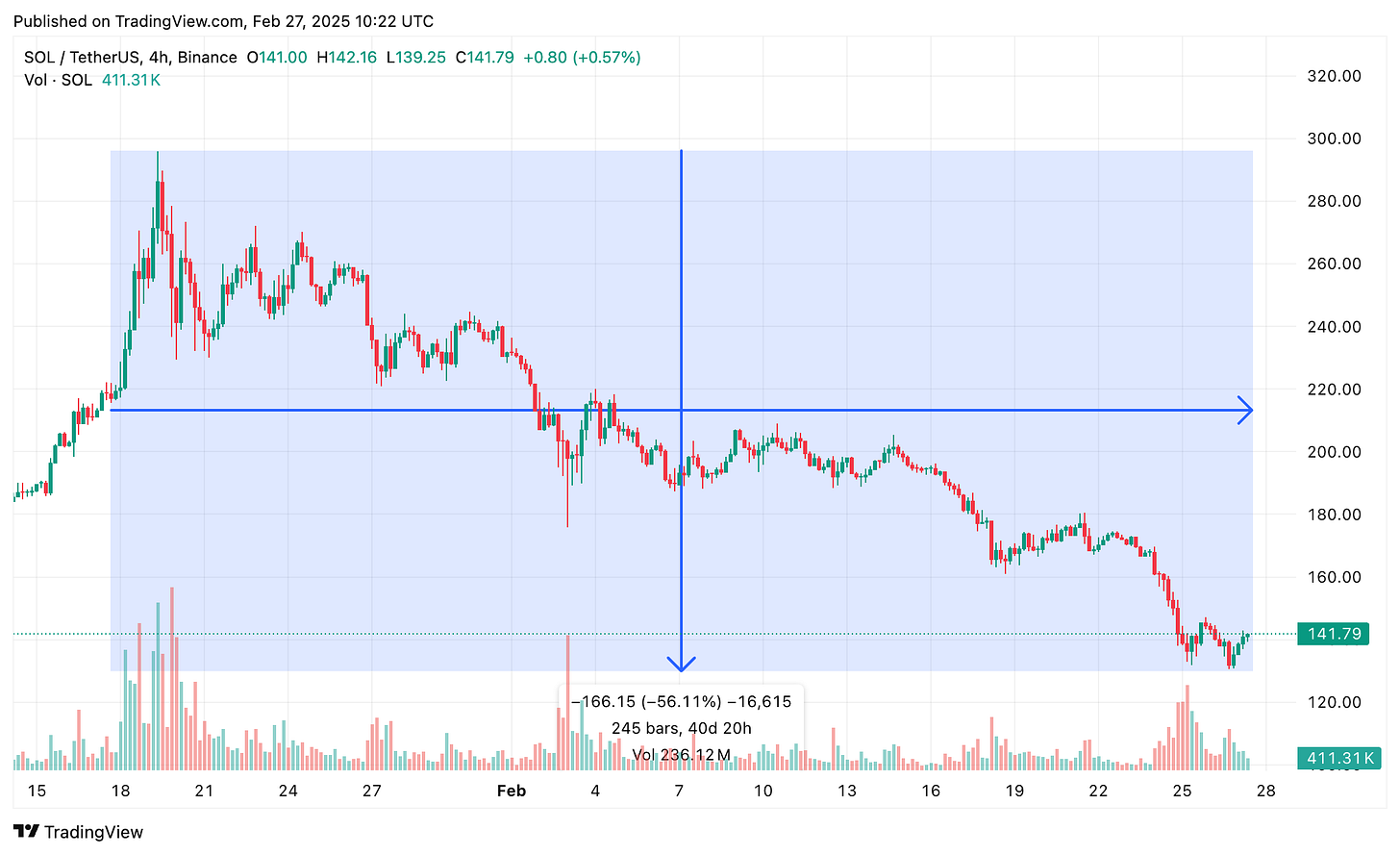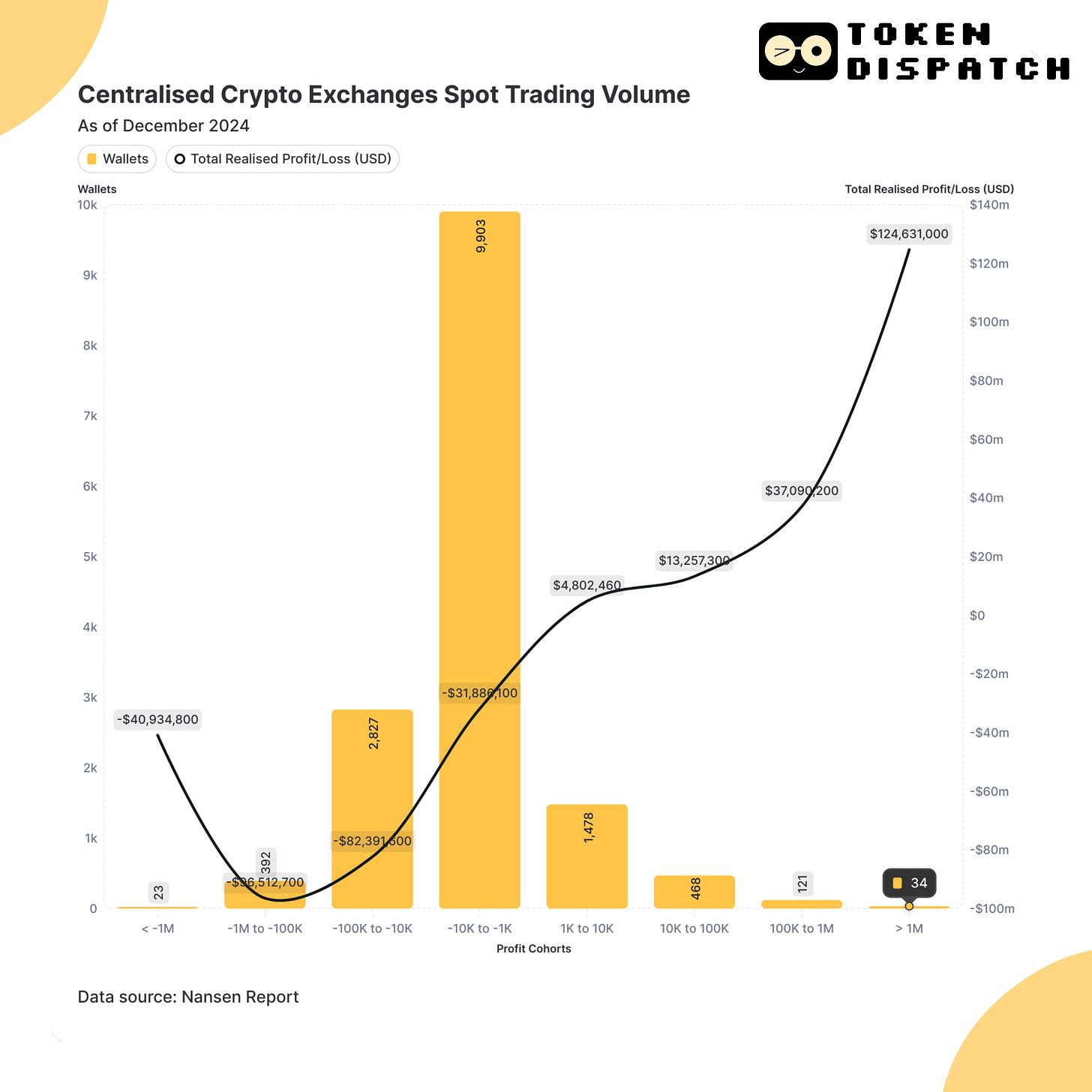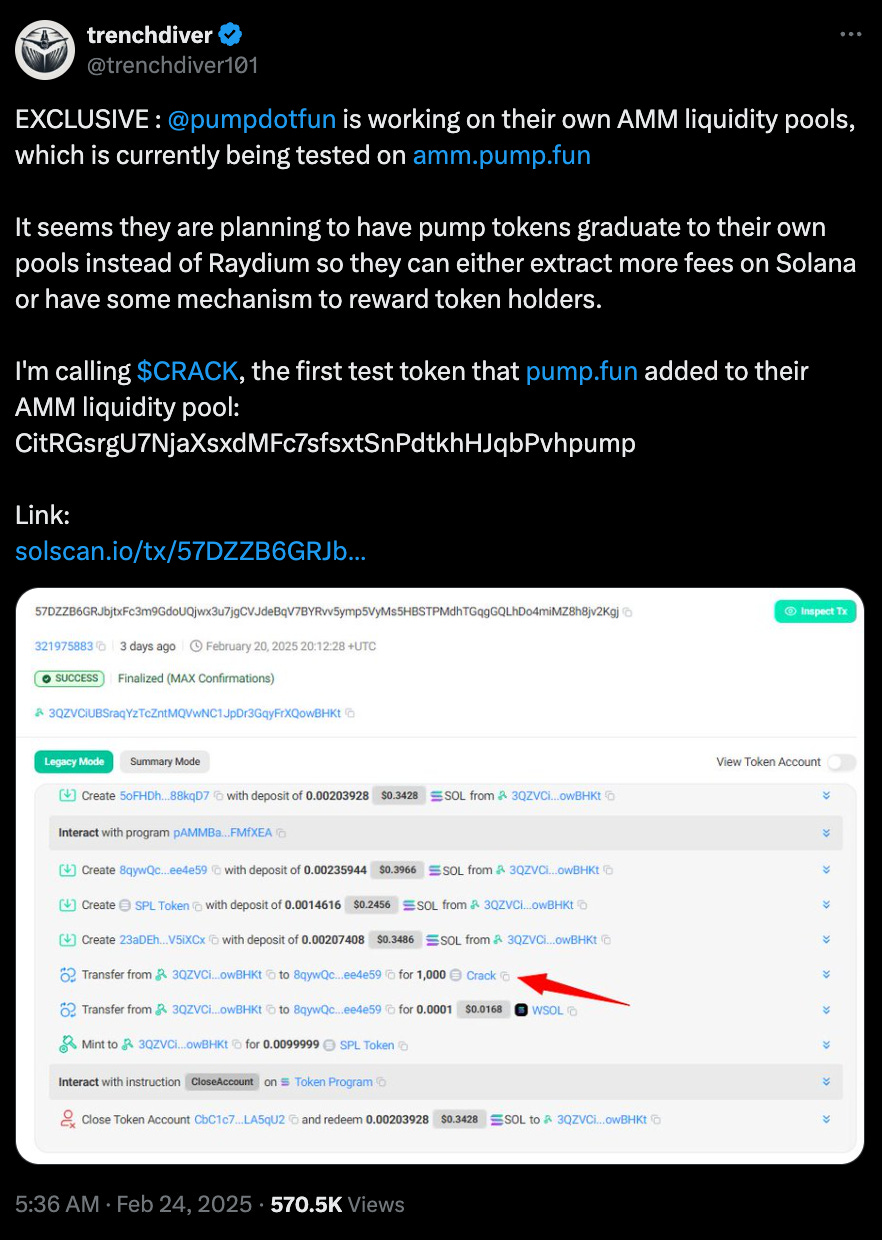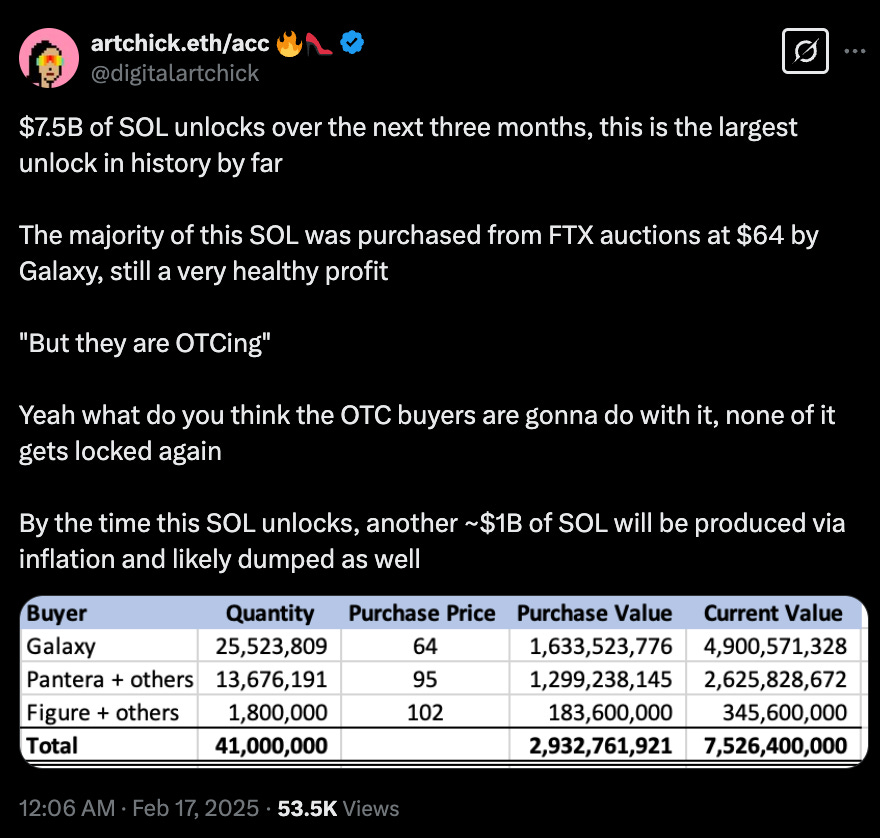Hello dispatchers!
If your SOL bag is feeling particularly heavy these days, you're not alone.
Solana has transitions from its euphoric January highs to today's sobering reality.
Plummeted over 50% from its $293 all-time high to as low as $132
Underperformed even ETH (down 18%) with a painful 38% monthly decline
Lost over $22 billion in memecoin market cap
Faced a perfect storm of presidential token scandals and protocol wars
Today we're diving deep into the multiple crises converging on Solana's ecosystem, from Pump.fun's potential betrayal of Raydium to the looming $2 billion token unlock that has even major market makers pulling funds.
Is this the end of Solana's memecoin-fuelled rally, or just a violent rotation into its next phase? Let's find out.
Explore Verified DApps - All in One Place!
The Damage Report
Fortunes change fast. Even faster in crypto.
Less than two months ago, Solana was the golden child of this bull market, reaching a staggering $293 as the TRUMP token launch catapulted the ecosystem to new heights. Today, it's struggling to hold above $140 — a staggering 50% plunge that has surpassed even the broader crypto market's decline.
Get 17% discount on our annual plans and access our weekly premium features (HashedIn, Wormhole, Rabbit hole and Mempool) and subscribers only posts.
The carnage isn't limited to SOL's price. The entire Solana ecosystem has felt the tremors.
Solana DEX trading volumes dropped to a five-week low of $2.61 billion last week
Solana's decline this month (38%) has significantly outpaced Ethereum's (18%)
SOL is now at its lowest price point since October 2024, erasing nearly four months of gains
The irony? The downfall is unfolding just as institutional interest was peaking with hit multiple fund issuers filing applications based on its spot price.
Franklin Templeton became the latest asset manager to file for a Solana ETF last week, joining Grayscale, Bitwise, Canary, 21Shares, and VanEck.
Even as the broader crypto market is going through a bloody phase, Solana's pain has been particularly acute. Bitcoin is down roughly 20% from its peak, while Ethereum has shed 19% over the past month. Solana's 38% drop in the same period signals something more than just market correlation.
The question on everyone's mind: what went so terribly wrong for the "Ethereum killer" blockchain that was supposed to lead this bull market?
Presidential Token Disasters
If Solana's current wounds could be traced to one fateful origin, it might be the moment when cryptocurrencies became political playthings.
On February 14, Argentine President Javier Milei promoted the Solana-based $LIBRA token on social media, triggering a frenzy that briefly sent the token to a $4.6 billion valuation. Hours later, insiders allegedly siphoned over $107 million worth of liquidity in what Galaxy Digital described as a "rug pull," causing a catastrophic 95% collapse.
The fallout was immediate and severe. More than 86% of wallets that bought Milei's memecoin ended up losing money, according to research from Nansen.
The scandal triggered political backlash in Argentina, with opponents calling for Milei's impeachment. Milei hastily deleted his promotional posts, claiming he had "little to no knowledge about the token."
This disaster came just weeks after a similar scenario played out with the Trump and Melania tokens on Solana during inauguration weekend. Both tokens initially soared to multi-billion dollar valuations before crashing spectacularly, leaving most investors with massive losses.
Read: When Presidents Play With Memes 🏛️
The repeated pattern of presidential endorsements followed by token crashes severely damaged trust in Solana's ecosystem. As Brian Armstrong, CEO of Coinbase, stated after the Libra debacle: "Some memecoins have clearly gone too far," calling on the industry to "purge the bad actors."
The reputational damage extends beyond just the tokens themselves. By hosting these controversial launches, Solana has become associated with what Edward Wilson, marketing lead at DeFi project OneBalance, calls "predatory" products that "prey" on investors.
Block That Quote 🎙️
Chris Chung, Founder of Solana trading platform Titan
"When Melania launched after Trump, it brought the realisation home that some teams were purely extractive and really stole the thunder of the Trump launch. The last wave with the Libra coin was the nail in the coffin."
Chung's analysis cuts to the heart of Solana's current crisis – it wasn't just one presidential token disaster, but the rapid succession of them that revealed a pattern of exploitation that's severely damaged trust in the ecosystem.
Even Solana's leadership recognises the problem.
Mert Mumtaz, CEO of Solana developer platform Helius, announced he was hiring a forensic researcher to help prevent fraudulent activity just days after Libra crashed.
The Pump.fun vs Raydium Protocol War
Just as Solana was reeling from the presidential token scandals, a new crisis emerged from within its own ecosystem.
Over the weekend, crypto sleuth "trenchdiver" discovered evidence that Pump.fun – the wildly successful memecoin launchpad that helped fuel Solana's resurgence – was testing its own automated market maker (AMM) protocol.
This development rattled the ecosystem, particularly for Raydium, Solana's dominant DEX.
Why? The economics are simple but massive.
Currently, when a token on Pump.fun generates enough activity, it "graduates" to Raydium's liquidity pools for further trading. This arrangement has been incredibly lucrative for Raydium, with DEX Screener data showing that over 30% of Raydium's daily trading volume comes from Pump.fun tokens. At a 0.25% fee on every swap, this represents millions in daily revenue.
The market's reaction was swift and brutal. Raydium's RAY token plummeted 25% as traders digested the implications of Pump.fun potentially cutting out the middleman.
"It seems they are planning to have pump tokens graduate to their own pools instead of Raydium so they can either extract more fees on Solana or have some mechanism to reward token holders," trenchdiver explained.
Pump.fun's potential motivations are clear. The platform has amassed over $500 million in fees since its January 2024 launch, but it misses out on the long-term trading fees once tokens move to Raydium.
With its own AMM, Pump.fun could potentially "double its revenue if market conditions persist," said Shoal Research founder Gabriel Tramble.
Raydium's core contributor "InfraRAY" attempted to downplay concerns, calling the market's 30% haircut on RAY tokens "overblown." He warned that any pivot to a new AMM could face "myriad issues: inadequate supporting infrastructure, low demand for migrated tokens, a flop on volume at launch."
The market didn’t buy that argument. With Pump.fun's unparalleled success in launching tokens (albeit with a 95% failure rate), many believe it could succeed in building its own liquidity ecosystem, further fragmenting Solana's already complex DeFi landscape.
Pump.fun has not publicly acknowledged or confirmed plans to launch its own AMM pools, but the damage to Raydium has already been done.
The $2B March Unlock Anxiety
Beyond presidential token scandals and ecosystem infighting, Solana now faces what could be one of the most significant challenges yet: a massive token unlock that threatens to flood the market with selling pressure.
On March 1, over 11.2 million SOL tokens – worth approximately $2 billion at current prices – will be unlocked and enter circulation. The majority of these tokens were purchased at FTX auctions for around $64 per SOL, meaning their current holders are sitting on substantial unrealised profits even after the recent pullback.
This potential selling pressure has market participants on edge, as evidenced by recent on-chain activity. Crypto market maker Wintermute withdrew over $38.2 million worth of SOL from Binance in the 24 hours leading up to February 24, according to Arkham Intelligence data. This move, just days ahead of the unlock, has been interpreted by many as positioning for further downside.
Crypto analyst Artchick.eth highlighted the scale of the upcoming unlock.
The math is simple but concerning. Even after SOL's recent decline, these investors are still looking at huge potential profits.
Artchick.eth implied that there's little incentive for these firms to continue holding through market uncertainty.
Where Next for Solana?
Despite the triple threat of presidential token fallout, ecosystem power struggles, and looming token unlocks, not everyone is ready to write Solana's obituary.
"Claims of Solana's demise due to this debacle are exaggerated. Memecoin mania would eventually die down given its zero-sum nature and the fact that most participants lose money," GSR analyst Carlos Guzman told DL News.
Several potential catalysts could help Solana weather this perfect storm.
First, the prospect of spot Solana ETFs remains on the horizon.
"There are additional reasons to be optimistic about Solana, including a possible SOL ETF and coming regulatory clarity, which are likely to boost investor confidence," Guzman added.
Second, Solana's technical fundamentals remain strong. Network performance issues that plagued previous cycles have largely been resolved, with no major outages in months. Transaction speeds and costs continue to outpace most competitors, providing a solid foundation for rebuilding.
From a market perspective, technical analysis suggests several key support levels to watch.
The 200-day moving average around $110
The psychologically important $100 round number
The previous major resistance zone at $80-90
Looking at the ETH/BTC and SOL/BTC ratio charts provides another intriguing perspective.
"The SOL/BTC ratio is on an almost identical path to the ETH/BTC ratio," suggesting Solana may be "speedrunning" Ethereum's price trajectory against Bitcoin, said Blockworks analyst David Canellis.
If this pattern holds, SOL could be in for a period of consolidation similar to what ETH experienced between May 2021 and January 2023, before ETH eventually declined further against BTC.
It will be crucial to see if Solana's memecoin-driven growth model sustains, or does the ecosystem need to pivot toward more enduring use cases?
Token Dispatch View 🔍
Solana's dramatic decline reveals an ecosystem at a crucial juncture. This is beyond a mere crypto correction — it's a question on the sustainability of Solana's growth model.
The memecoin mania that propelled Solana to $293 was always built on shaky foundations. When the tokens of sitting presidents and first ladies become vehicles for insider enrichment at retail expense, the party was bound to end badly. Beyond the memecoin bubble burst, what’s more interesting was how quickly it transformed from Solana's greatest strength to its most significant vulnerability.
Mert Mumtaz hiring forensic researchers, Raydium fighting to preserve its business model, and Pump.fun potentially building a walled garden all point to growing pains that were inevitable after such explosive growth for an ecosystem that is struggling to mature.
The $2 billion token unlock on March 1 will be a litmus test. With Galaxy Digital, Pantera, and others sitting on billions in unrealised gains from $64 entry prices, the temptation to secure profits amid deteriorating sentiment could prove irresistible.
Market makers like Wintermute aren't withdrawing $38 million "just in case" — they're positioning for what they see coming.
The ETF filings tell a different story though. Franklin Templeton doesn't submit SEC paperwork on a whim. The fundamental case for Solana remains: its technical performance exceeds most competitors, and its developer activity continues to flourish despite the price decline.
Read: 7,625 Reasons Why Solana Might Win ✌️
When memecoin volumes evaporate, other use cases might finally have room to breathe. For investors, the parallels between SOL/BTC and ETH/BTC charts offer an intriguing roadmap. If Solana is indeed "speedrunning" Ethereum's trajectory, we might expect consolidation before further weakness.
What's clear though is that Solana must evolve beyond being crypto's casino. The projects that survive this correction will likely be those building sustainable value rather than extractive token schemes.
Token Dispatch is a daily crypto newsletter handpicked and crafted with love by human bots. You can find all about us here 🙌
If you want to reach out to 200,000+ subscriber community of the Token Dispatch, you can explore the partnership opportunities with us.
Disclaimer: This newsletter contains sponsored content and affiliate links. All sponsored content is clearly marked. Opinions expressed by sponsors or in sponsored content are their own and do not necessarily reflect the views of this newsletter or its authors. We may receive compensation from featured products/services. Content is for informational purposes only, not financial advice. Trading crypto involves substantial risk - your capital is at risk. Do your own research.


